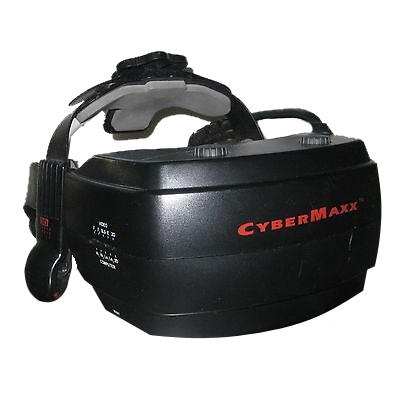|
History
After the release of the StunMaster, VictorMaxx quickly understood that their product was not on par with the expectation of the market. The StunMaster was rushed to market to beat the Virtua Sega HMD, which, in the end, would never saw the light of day. After receiving a lot of criticism, VictorMaxx decided to stall all future development of the StunMaster to instead work on an upgraded HMD (Head Mounted Display) to would address the criticism, most notability the ones related to the screen resolution and picture clarity. To this end, VictorMaxx dropped the monoscopic concept in favor of a dual display (stereoscopic) and focused its energy on the PC/Mac market. The worked started in late 1993 and by January 1994, a prototype of the CyberMaxx was being displayed privately during the CES. The work continued throughout the year and in September 1994, Bungie Sofware announce than their upcoming title, called Marathon, would support virtual reality through the use of the CyberMaxx VR Headset. The stage was set, the CyberMaxx was ready to change the world of gaming forever …
Release
The CyberMaxx was first released in November 1994. The first model, called model 120, was sold for $699. The HMD featured a twin 505 x 230 resolution display (120.000 pixels per display), but was not yet compatible Apple Computer. It was stated by Bungie Sofware that support for the CyberMaxx would be added to Marathon via a patch whenever CyberMaxx would be ready to support Apple computers, indicating that VictorMaxx were working on the ADB interface to allow connectivity with Macs. Details on the Model 120 are sketchy, but we know it had a fairly limited reach. The financial statements shown that revenue from the CyberMaxx in 1994 were only $606,143, which, at a sale price of $699, represent only 867 units.
In May 1995, Virtual I-O released their own HMD called the Virtual i-glasses!. Sold for $499, the HMD were cheaper and better than the CyberMaxx. VictorMaxx quickly switched gear and released in August 1995 and updated version of the CyberMaxx, called the CyberMaxx 2.0. This version now had a 180.000 pixels per display resolution and would now support any devices that use a composite output. To this end, the CyberMaxx was compatible with all game console of the times, but not with the benefit of head-tracking. The system was now $200 more expensive, with a retail price of $899. Macs support was still missing from this release and would in fact never happen.
Demise
Sadly the released of the version 2.0 was not enough to entice customers into buying their HMD. It was now almost twice the price than the Virtual i-glasses! and were proposing a slightly inferior screen resolution. With sales of around $670,729 in 1995, the company had failed to sell more than a thousand units in a year. In early 1996, the management of the Company concluded that its headset was not likely to gain widespread consumer acceptance in the immediate future at a suggested retail price of $889. In February 1996, the Company suspended production of the CyberMaxx model 2.0 and in March 1996 lowered the price of the CyberMaxx model 2.0 for the purpose of stimulating sales at a suggested retail price of $499. During the second quarter of 1996, it became apparent that the reduced price of the CyberMaxx model 2.0 was not going to stimulate sales and the management of the Company made the decision to cease marketing virtual
reality hardware products. The Company liquidated its remaining CyberMaxx inventory and parts and would eventually close down completely in 1998.

